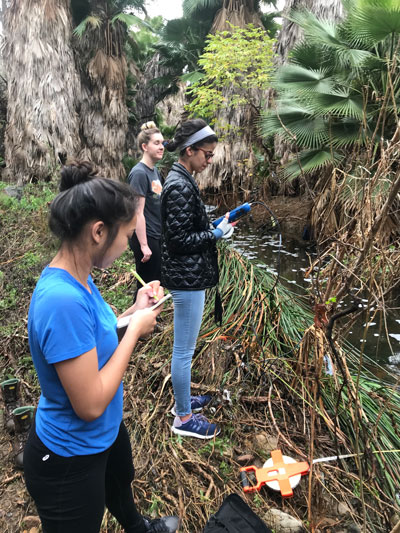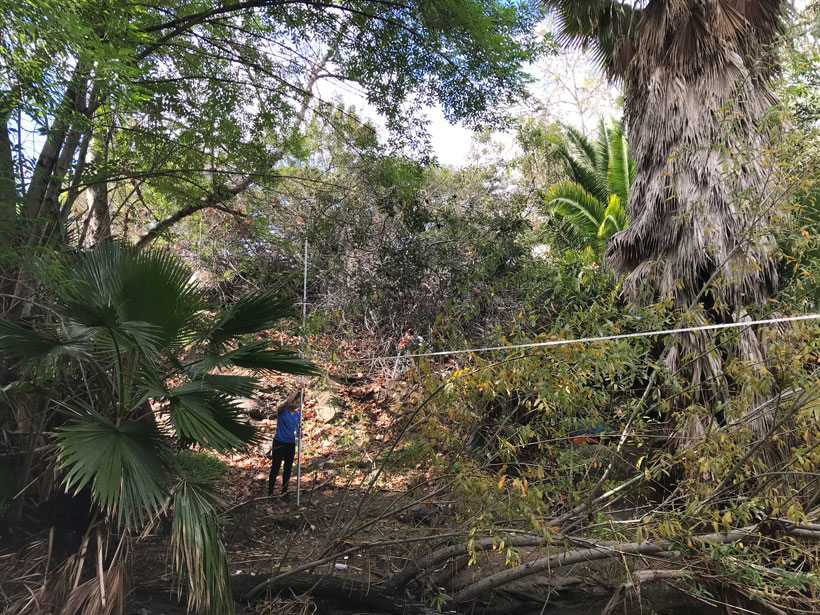Southern California’s picturesque palm trees create spectacular visuals, but they may also increase fire danger across the arid region, according to new research.
When flying embers hit the dead palm fronds that hang on the trees, the trees “go up like Roman candles.”
When flying embers hit the dead palm fronds that hang on the trees, the trees “go up like Roman candles,” said Alicia Kinoshita, a civil engineer and hydrologist at San Diego State University who presented the research at the Geological Society of America meeting in Phoenix in September. That’s especially the case in many urban creeks and canyons throughout the greater San Diego and Los Angeles areas, which are filled with palm trees and other nonnative plants.
Most palm species are not native to Southern California. Neither is Arundo donax, a common reedlike plant that grows quickly and has filled in many Southern California riparian areas and canyons.
Palms and Arundo are both highly flammable, largely because the dead leaves hang onto the plants and trees, said Jon Keeley, a research scientist at the U.S. Geological Survey and adjunct professor at the University of California, Los Angeles, who was not involved in the new research. He noted that even though they’re not native to the region, the palms themselves may not be the problem. They can become a problem, however, when unpruned specimens grow in untended canyons.
Fire Presents a Learning Opportunity
In 2018, Kinoshita and other researchers were supported by the San Diego River Conservancy to restore a riparian area along Alvarado Creek (a tributary of the San Diego River in the Del Cerro part of San Diego) when they were presented with an opportunity. They had just written a proposal to remove some invasive plants from the creek—they had hypothesized the plants created fire and flood risks by clogging the creek bed—when lo and behold, a fire broke out in the very spot.
The Del Cerro fire, which ended up burning about 15 hectares (38 acres) in June 2018, gave Kinoshita and her team the perfect test case to examine how native and nonnative vegetation impacts postfire processes.
.

.
The team used satellite data to look at burned areas and estimate vegetative health, as well as to look at burn severities both for the Del Cerro fire and several other larger urban fires, including the Creek Fire, which burned more than 6,313 hectares (15,600 acres) in Los Angeles County in December 2017 and January 2018. They found that nonnative vegetation burned at much higher severities than native vegetation.
“The most severe burns were where we see palms, and the least severe were in the [native] chaparral areas,” Kinoshita said. Another fire also occurred along Alvarado Creek in September 2019; following this fire, Kinoshita’s team found a “clear break” where the fire had jumped over a section of vegetation. The break was precisely where the team had removed some of the nonnative vegetation.

Additionally, Kinoshita noted, researchers found that riparian zones burned more severely than upland areas. “We tend to think of these riparian systems as good [fire] buffers,” she said. “You don’t intuitively think of fires happening on rivers—they’re wet.”
But riparian systems with invasive species like palms and Arundo, which produce constant fuel loads, actually make an already fire-prone region even more dangerous, she said. That’s in part due to increased human interaction with these riparian areas, including power lines, recreation, and transient encampments: When the heavy fuel loads of the nonnative vegetation meet any kind of spark, these canyons become fire corridors.
This research “might change how we look at riparian systems in urban areas,” Kinoshita said. Of course, removing all the palms, Arundo, and other nonnative vegetation isn’t necessary or feasible, she said.
Vegetation’s Role
Dozens to hundreds of small brush fires burn in Southern California canyons each year. These small brush fires start mostly in the summer, are mostly caused by humans, and are mostly the “least threatening” types of fires to large numbers of homes and people, Keeley said—not like the wind-driven fires burning now across California.
“You could make a case that the type of vegetation plays a role in [starting] summer fires…and there is reason to believe that the type of vegetation can affect how these fires burn,” Keeley said. “But the same doesn’t hold for these autumn wind-driven fires.” Palms, he said, play a role in the wind-driven fires only if their dead fronds aren’t cleared from roofs or the ground near houses. But that would be true of any dried leaves collecting on roofs or the ground—it isn’t special to palms.
Nonetheless, Kinoshita’s team’s preliminary research suggests that mapping the nonnative vegetation by agencies such as the California Invasive Plant Council might help us to know where the fire danger is highest. In the meantime, where invasive vegetation is removed through fire, restoration, or any other process, there is an opportunity to keep it out, she said.
“If it keeps growing back,” Kinoshita said, “it just provides another opportunity for more fire.”
—Megan Sever (@MeganSever4), Science Journalist
Citation:
Sever, M. (2019), Iconic palms add to fire danger in Southern California, Eos, 100, https://doi.org/10.1029/2019EO136574. Published on 22 November 2019.
Text © 2019. The authors. CC BY-NC-ND 3.0
Except where otherwise noted, images are subject to copyright. Any reuse without express permission from the copyright owner is prohibited.

